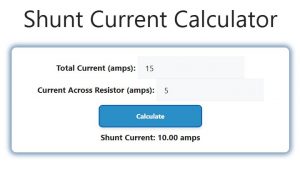About Shunt Current Calculator (Formula)
A Shunt Current Calculator is an essential tool for electrical engineers and technicians, helping to calculate the shunt current in a circuit. The shunt current is the difference between the total current (It) flowing into a node and the reference current (Ir) flowing out of that node. Understanding shunt current is vital for accurate measurements and ensuring the safety and efficiency of electrical systems.
Formula
The formula used in the Shunt Current Calculator is:
Is = It − Ir
Where:
- Is = Shunt current
- It = Total current
- Ir = Reference current
How to Use
Using the Shunt Current Calculator is straightforward. Follow these steps:
- Input the Total Current (It): Measure the total current flowing into the circuit.
- Input the Reference Current (Ir): Determine the reference current flowing out of the circuit.
- Calculate Shunt Current (Is): The calculator will automatically compute the shunt current by applying the formula Is = It − Ir.
- Interpret Results: Analyze the shunt current value to ensure it aligns with your circuit requirements.
Example
Suppose you have a total current (It) of 15 A flowing into a node and a reference current (Ir) of 5 A flowing out. By applying the formula:
Is = It − Ir
Is = 15 A − 5 A
Is = 10 A
In this case, the shunt current (Is) would be 10 A.

FAQs
1. What is a shunt current?
Shunt current is the current that flows through a shunt resistor or path in a circuit, used to measure or control the overall current.
2. Why is it important to calculate shunt current?
Calculating shunt current helps ensure that electrical systems operate within safe limits and function efficiently.
3. Can I use the Shunt Current Calculator for AC circuits?
Yes, the calculator can be used for both AC and DC circuits, as long as you input the appropriate current values.
4. What happens if shunt current is too high?
If the shunt current is excessively high, it may indicate a fault in the circuit or that the load is too great, which can lead to overheating and potential damage.
5. How accurate is the Shunt Current Calculator?
The accuracy depends on the values entered for total current and reference current. Always ensure measurements are precise.
6. What units are used in the Shunt Current Calculator?
Typically, the calculator uses amperes (A) for current measurements.
7. Can I manually calculate shunt current without the calculator?
Yes, you can manually calculate shunt current using the formula Is = It − Ir.
8. Is a shunt current the same as a shunt resistor?
No, a shunt resistor is a component used to measure current, while shunt current refers to the current flowing through that resistor.
9. How do I find the reference current (Ir)?
The reference current can usually be determined from circuit specifications or by measuring the current flowing out of a node.
10. Is there a maximum limit for shunt current?
Yes, there are safe operating limits for shunt current, which vary based on the circuit design and components used.
11. Can shunt current calculations help in troubleshooting?
Yes, analyzing shunt current can assist in diagnosing issues within electrical systems, such as identifying overloads or faults.
12. Do I need special tools to measure total current (It)?
You may need an ammeter or a clamp meter to accurately measure total current.
13. How does temperature affect shunt current readings?
Temperature changes can affect resistance in components, potentially leading to variations in current readings.
14. Can shunt current be negative?
Yes, if the reference current exceeds the total current, the shunt current can be negative, indicating an unusual situation in the circuit.
15. Are there any safety precautions when measuring current?
Always ensure proper safety protocols are followed, including using insulated tools and working on de-energized circuits when possible.
Conclusion
The Shunt Current Calculator is an invaluable resource for anyone working with electrical circuits. By accurately determining shunt current, users can maintain system integrity, troubleshoot issues, and enhance overall efficiency. Remember to always verify your measurements and adhere to safety guidelines when working with electrical systems.